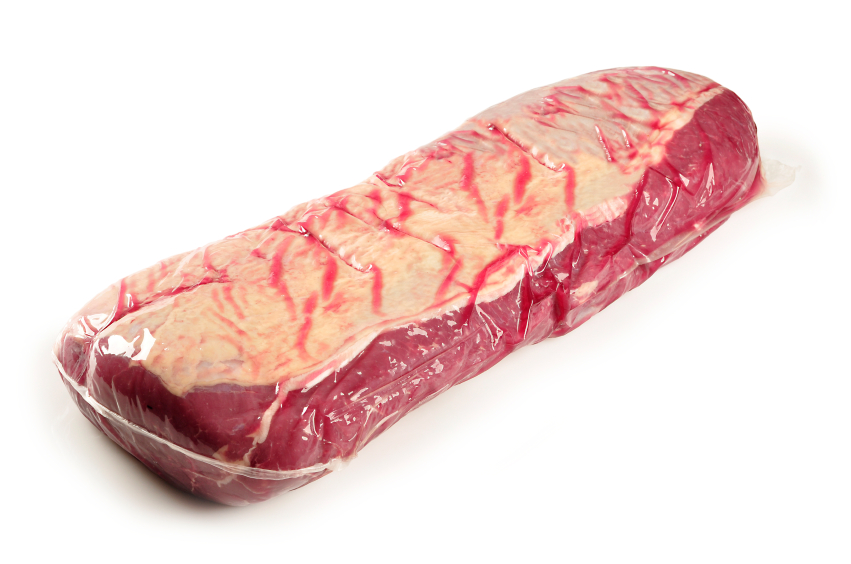Vacuum Packaging

Vacuum packaging is another way to increase the shelf life of food products. Here the product is placed in an air-tight pack, the air sucked out and the package sealed. By removing air from around the product, the levels of oxygen in the packaging are reduced, impeding the ability of oxygen-breathing microorganisms to grow and spoil the product. The lack of oxygen also reduces the amount of spoilage due to oxidation – the process that causes apples and bananas to turn brown, for example.
A certain amount of oxygen will remain, however, because it is not possible to create a total vacuum. Air contains around 21 per cent oxygen at normal atmospheric pressure – 1000 millibar. As the air is withdrawn during the vacuum packaging process, the pressure inside the package is reduced.
If, for example, the pressure is reduced to 100 millibar, an equivalent of around 2.1 per cent oxygen will remain; if it is reduced to 10 millibar, there will still be in effect 0.21 per cent oxygen present.
Is vacuum packaging more effective than modified atmosphere packaging? As with most things, it is a case of ‘horses for courses’ – it depends on the product being packaged.
MAP is certainly a more versatile process than vacuum packaging. Vacuum packaging is essentially a ‘one size fits all’ technology – it relies solely on removing air. MAP on the other hand can be tailored to the particular foodstuff, with different gases and different proportions of gas in the mixture used to give the maximum shelf life for the particular product and to retain the quality and appearance of the product.
For example for packaging seafood, the proportion of carbon dioxide and oxygen in the modified atmosphere can by varied depending on the type of fish: oily fish benefit from a different atmosphere compared with, for example, prawns. The gas mixture used for red meat is different to that used for, say, bread.
One area where MAP does score well when compared with vacuum packaging is in the presentation of the product. In vacuum packaging, as the pressure within the packaging is reduced the packaging material collapses and forms itself tightly around the product. For some products, such as fresh meat, this can distort the appearance of the product. Other products, such as shredded cheese, are not suitable for vacuum packaging because the pressure of the packaging material on the product would cause the product to deform and to lose important characteristics.
Another aspect in which the two processes differ is in the ease of quality control of the packaging process. In MAP packaging, air is flushed from the package and replaced with the gas mixture, making it possible to constantly monitor the gas content of the package during the packaging process. Once the package is sealed, any leakage of the modified atmosphere can be detected, enabling the integrity of the seal to be assured. For vacuum packaging, because there is no gas present in the package, leak testing is typically done through manual inspection, making quality control less straightforward.
If you want to know more about MAP we suggest that you also visit www.dansensor.com
A certain amount of oxygen will remain, however, because it is not possible to create a total vacuum. Air contains around 21 per cent oxygen at normal atmospheric pressure – 1000 millibar. As the air is withdrawn during the vacuum packaging process, the pressure inside the package is reduced.
If, for example, the pressure is reduced to 100 millibar, an equivalent of around 2.1 per cent oxygen will remain; if it is reduced to 10 millibar, there will still be in effect 0.21 per cent oxygen present.
Is vacuum packaging more effective than modified atmosphere packaging? As with most things, it is a case of ‘horses for courses’ – it depends on the product being packaged.
MAP is certainly a more versatile process than vacuum packaging. Vacuum packaging is essentially a ‘one size fits all’ technology – it relies solely on removing air. MAP on the other hand can be tailored to the particular foodstuff, with different gases and different proportions of gas in the mixture used to give the maximum shelf life for the particular product and to retain the quality and appearance of the product.
For example for packaging seafood, the proportion of carbon dioxide and oxygen in the modified atmosphere can by varied depending on the type of fish: oily fish benefit from a different atmosphere compared with, for example, prawns. The gas mixture used for red meat is different to that used for, say, bread.
One area where MAP does score well when compared with vacuum packaging is in the presentation of the product. In vacuum packaging, as the pressure within the packaging is reduced the packaging material collapses and forms itself tightly around the product. For some products, such as fresh meat, this can distort the appearance of the product. Other products, such as shredded cheese, are not suitable for vacuum packaging because the pressure of the packaging material on the product would cause the product to deform and to lose important characteristics.
Another aspect in which the two processes differ is in the ease of quality control of the packaging process. In MAP packaging, air is flushed from the package and replaced with the gas mixture, making it possible to constantly monitor the gas content of the package during the packaging process. Once the package is sealed, any leakage of the modified atmosphere can be detected, enabling the integrity of the seal to be assured. For vacuum packaging, because there is no gas present in the package, leak testing is typically done through manual inspection, making quality control less straightforward.
If you want to know more about MAP we suggest that you also visit www.dansensor.com




